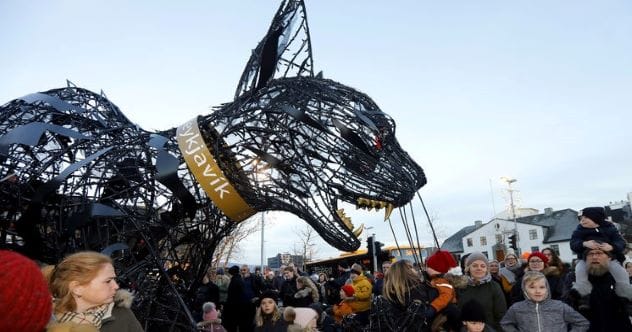Christmas often brings to mind cozy family gatherings, twinkling lights, and festive feasts. We imagine stockings hung by the chimney, carols filling the air, and the joy of unwrapping presents. But around the world, Christmas traditions can look very different, sometimes wonderfully weird and surprisingly unique!
While many of us share common customs like decorating trees and enjoying turkey dinners, some countries have practices that might seem quite out of the ordinary. Get ready to explore ten Christmas traditions that step away from the familiar and embrace something truly distinctive. Let’s dive into a world of festive oddities!
10. Czech Republic: Shoe Tossing for Love
Hoping to find your soulmate during the holidays? In the Czech Republic, a peculiar tradition offers a playful glimpse into the future. A single woman stands with her back to a door and throws a shoe over her shoulder. If the shoe lands with its tip pointing towards the door, it’s believed she’ll get married in the coming year.
Other cultures have their own ways of seeking love at Christmas. In Poland, during the Wigilia (Christmas Eve dinner), straw is placed under the tablecloth. Pulling out a green piece of straw hints at an upcoming marriage, while yellow suggests another year of single life. Meanwhile, in Sweden, finding an almond in your risgrynsgröt, a cinnamon-infused rice pudding, means love is on its way. These charming customs are celebrated globally, often just for fun!
9. Estonia: A Naked Family Sauna
In Estonia, families share a uniquely relaxing moment after their traditional Christmas meal. What is it? They all gather in a sauna, completely nude! It might sound surprising, but it’s a cherished part of their Joulud (Christmas) celebrations.
Considering the average December temperature in Tallinn hovers around -5°C (23°F), a warm sauna visit is quite a blessing. Families prepare their homes for the holidays, decorate, and then, before heading to midnight church service, they enjoy a steamy session. Imagine sitting with your family, bare and sweating, on a chilly winter evening! This isn’t exclusive to Estonians; Finns and other cultures in cold climates also partake in similar traditions.
8. Netherlands: Sinterklaas and Zwarte Pieten’s Judgment
Each year on December 5th, children in the Netherlands eagerly await Sinterklaas, who arrives to give them gifts. He’s accompanied by his helpers, known as Zwarte Pieten (Black Peters). They carry a list of all the naughty children, who don’t receive gifts but rather bits of coal.
According to Dutch legend, Sinterklaas lives in Madrid, Spain. He wears a red clerical robe and a bishop’s miter. His attendants, the Zwarte Pieten, are said to be dark from chimney soot. However, this aspect has become a point of discussion in the modern Netherlands due to its controversial nature.
The Zwarte Pieten supposedly put the naughtiest children in sacks and take them back to Spain! This is humorously seen as a playful payback for the time the Netherlands was under Spanish rule centuries ago.
7. Iceland: The Fearsome Yule Cat
In Iceland, the pagan winter solstice festival of Yule overlaps with Christmas. And with Yule comes the Jólakötturinn, or Yule Cat. This isn’t your average friendly feline; it’s a monstrous cat that prowls the land at dusk, hungry and looking for prey! But it only targets a specific group: those who haven’t received or made a new piece of clothing for the celebration. This peculiar form of justice dates back to the Middle Ages, used to encourage farmworkers to finish their wool processing before winter.
So, the Yule Cat served as a rather terrifying motivator. It pushed people to work hard ensuring everyone had something new and warm to wear, thus avoiding being eaten. Children were encouraged to behave well, allowing adults to focus on their tasks, lest everyone face the giant cat’s wrath. This tale also has a practical side. With Reykjavik’s winter temperatures dropping to -10°C (14°F), new warm clothes were essential; if the cat didn’t get you, the cold might!
6. Switzerland: The Santa Claus World Championship
Head to the Swiss village of Samnaun for the ClauWau, the annual Santa Claus World Championship! Teams dressed as Father Christmas from all over the globe gather for a series of fun and festive sports. Think ski races, snowshoe sprints, sledding competitions, and even gingerbread baking contests. These unique events allow the winning team to claim some serious bragging rights.
In a recent championship, 20 Santa teams convened in this eastern Alps village. They competed in various categories, including a Santa downhill race, Christmas present collection and transport, and a geography-themed gingerbread bake-off. A crucial skill for any aspiring Santa, chimney climbing, was also part of the competition. After all the fun, the team “Teleschmutzlis” from Switzerland proudly took home the title.
5. Mexico: The Night of the Radishes
Every December 23rd in Oaxaca, Mexico, a unique art event called “Noche de Rábanos” or “Night of the Radishes” takes place. During this festival, Mexicans display incredible works of art carved from oversized radishes. These vegetables are sliced and sculpted into intricate figures and scenes. The event attracts about 100 contestants annually and is a tradition rooted in the colonial history of the 16th century.
The competition’s origins trace back to holiday market vendors who sculpted their radishes to make them more appealing to customers. This became so popular that in 1897, Governor Francisco Vasconcelos made it an official competition. It’s been a beloved Oaxacan tradition ever since. The festival starts in the morning, allowing visitors to watch artists create their sculptures, with the final masterpieces revealed in the evening. The celebration also features city-wide music, fireworks, and light displays.
4. Ukraine: Spider Webs on Christmas Trees
You might have heard of the German tradition of hiding a pickle ornament in the Christmas tree, with the first child to find it getting an extra gift. If you thought that was unique, wait until you hear about Ukraine! There, Christmas trees are often decorated with artificial spider webs. Why, you ask?
In Ukrainian culture, spiders and their webs are considered symbols of good luck. So, instead of just tinsel and baubles, they add spider webs to their trees, wishing for wealth and good fortune in the year ahead. This practice stems from an old Ukrainian Christmas folktale. One version tells of a poor widow who couldn’t afford to decorate her tree. Touched by her children’s tears, spiders spun beautiful, glistening webs all over the tree during the night. The next day, the family’s luck changed, and they lived prosperously.
3. USA: The Ever-Watching Elf on the Shelf
Unlike many ancient rituals on this list, Elf on a Shelf is a relatively new tradition, created by a mother and her daughters based on a family custom. Starting in Georgia, USA, it quickly gained popularity across the country. Armed with the Elf on a Shelf book and a “Scout Elf,” parents have a novel way to encourage good behavior from their children. If the kids misbehave, the elf will report back to Santa when it magically flies to the North Pole each night.
The real fun (or pressure!) comes when the Elf on a Shelf returns from its nightly report, choosing a new spot in the house each day to watch over the children. With over 15 million Scout Elves now “on duty,” they’ve been found in all sorts of creative, funny, and sometimes rather mischievous hiding places—leading to countless photos and videos shared online.
2. Latvia: Halloween-like Christmas Mummers
In Latvia, one Christmas tradition bears a striking resemblance to Halloween. Preparations for Christmas begin shortly after the Night of the Candles, a remembrance ceremony. This marks the season for Kekatas, a traditional masked procession. Latvians dress up in various masks and go door-to-door, singing, dancing, and playing games. It’s believed that the homes visited by this “Masque Procession” will be blessed with good luck. In return, the masked visitors often receive food and small gifts.
The masks, which can depict animals, people, or mythical creatures, are designed to ensure the participants remain unrecognized. Besides bringing good fortune, these masked well-wishers are also tasked with scaring away evil spirits, adding a protective element to their festive rounds.
1. Spain (Catalonia): The Pooping Log – Tió de Nadal
Perhaps one of the most peculiar and amusing Christmas customs comes from Catalonia, Spain: Tió de Nadal, often called Caga Tió or the “pooping log.” This Catalan version of Santa Claus is a small wooden log, usually with a smiling face painted on one end and wearing a traditional Catalan red cap.
In early December, families place the log near the fireplace and cover it with a blanket to keep it warm. Every night, children “feed” it nuts, chocolates, and other treats, hoping it will grow larger. Then, on Christmas Day or Eve, it’s time for the log to “reveal” its gifts. The idea is, the more you feed it, the more presents it will “poop out.” Traditionally, these gifts are small items like nougats, sweets, little toys, and money. To encourage Caga Tió, children sing special songs and hit it with sticks until it “delivers” the goodies. Children are also expected to behave well throughout December, or Caga Tió might not produce any presents at all!
These fascinating, funny, and sometimes fearsome traditions show just how diverse Christmas celebrations can be. Each custom, no matter how unusual to outsiders, holds special meaning and joy for those who practice it.
What are some of the most unusual holiday traditions you’ve encountered or heard about? We’d love to hear your stories!
Leave your comment below and share your thoughts. Which of these traditions surprised you the most?










